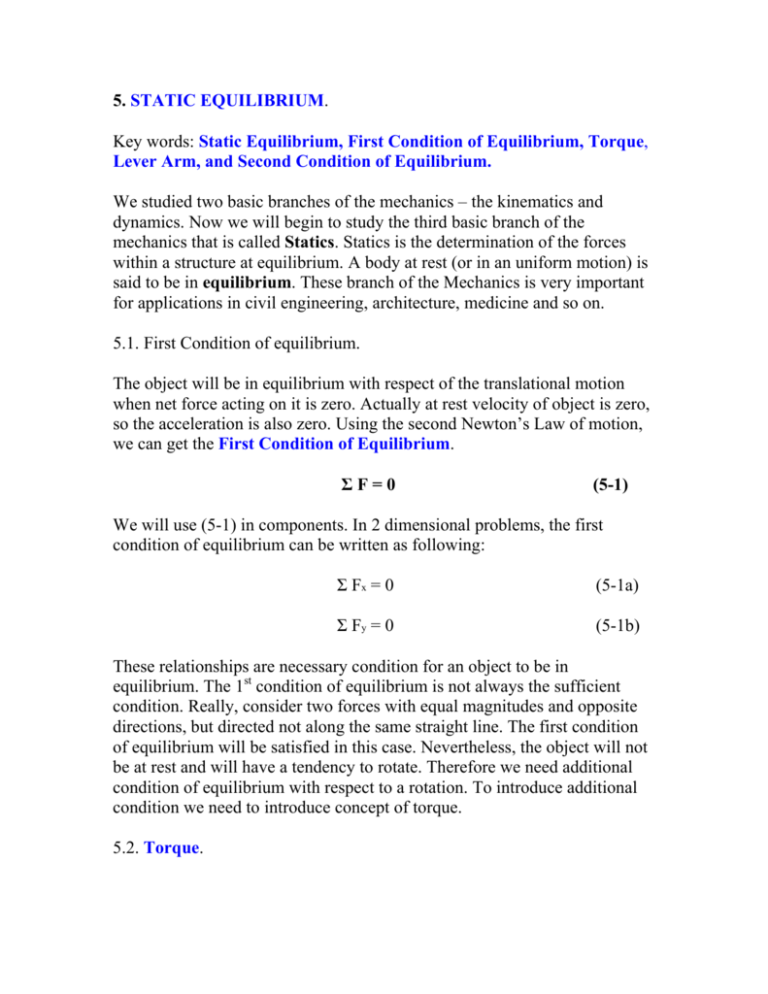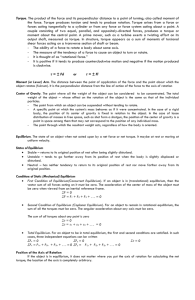5. STATIC EQUILIBRIUM. Key words: Static Equilibrium, First
advertisement

5. STATIC EQUILIBRIUM. Key words: Static Equilibrium, First Condition of Equilibrium, Torque, Lever Arm, and Second Condition of Equilibrium. We studied two basic branches of the mechanics – the kinematics and dynamics. Now we will begin to study the third basic branch of the mechanics that is called Statics. Statics is the determination of the forces within a structure at equilibrium. A body at rest (or in an uniform motion) is said to be in equilibrium. These branch of the Mechanics is very important for applications in civil engineering, architecture, medicine and so on. 5.1. First Condition of equilibrium. The object will be in equilibrium with respect of the translational motion when net force acting on it is zero. Actually at rest velocity of object is zero, so the acceleration is also zero. Using the second Newton’s Law of motion, we can get the First Condition of Equilibrium. ΣF=0 (5-1) We will use (5-1) in components. In 2 dimensional problems, the first condition of equilibrium can be written as following: Σ Fx = 0 (5-1a) Σ Fy = 0 (5-1b) These relationships are necessary condition for an object to be in equilibrium. The 1st condition of equilibrium is not always the sufficient condition. Really, consider two forces with equal magnitudes and opposite directions, but directed not along the same straight line. The first condition of equilibrium will be satisfied in this case. Nevertheless, the object will not be at rest and will have a tendency to rotate. Therefore we need additional condition of equilibrium with respect to a rotation. To introduce additional condition we need to introduce concept of torque. 5.2. Torque. It is understandable that to make object rotating about an axis of rotation we need a force. But it is also important not only the magnitude of this force but also the perpendicular distance from the axis of rotation to the line along which a force is acting (line of action of a force). This perpendicular is called lever arm. The rotating effect of a force also depends on the angle between the lever arm and a force. We will take all these circumstances into account if we introduced new physical quantity Torque that plays the same role for rotational motion as a force plays for translational motion. The magnitude of the torque can be determined as follows: τ= r F sinθ (5-2) Where r is the distance from the axis of rotation to the point where force F applied; F is the magnitude of the applied force; θ is the angle between the line of action of the force and a line connecting axis of rotation and the point at which the force is applied (see Fig. 5.1). Usually we will use the following sign convention: a positive sign is assigned to torques that act to rotate the object counterclockwise, and a negative sign to torques that act to rotate the object clockwise. From relationship (5-2) we can deduce that unit of torque in SI system is m N. There is no special name for this unit. 5.3. The second condition of equilibrium. Now we can formulate the Second Condition of Equilibrium: The sum of the torques acting on a body must be zero. In the 2D problems, we usually suppose that axis of rotation is directed along Z-axis and all forces are lying in the plane XOY. The all set of equations describing conditions of equilibrium can be written for this case as follows: Σ Fx = 0 (5.3a) Σ Fy = 0 (5.3b) Στ=0 (5.3c) Sum of X—components and sum of Y-components of all forces acting on an object and sum of torques of all these forces applied in the XOY plane must be equal zero. There are some specifics related to the Second condition of equilibrium. Torque of the force can be calculated with respect to different axis of rotation (real or virtual). So, with respect to which axis of rotation net torque must be zero? The answer is: in equilibrium, net torque must be zero with respect to any axis of rotation. Therefore, solving problems, we can choose any axis of rotation that makes our calculation easier. For example, we can choose as axis of rotation point at which unknown force is applied. In this case, the torque of this force will be zero. The number of unknown in the set of equations will be decreased by this way. It does not matter is the chosen axis real or virtual.








